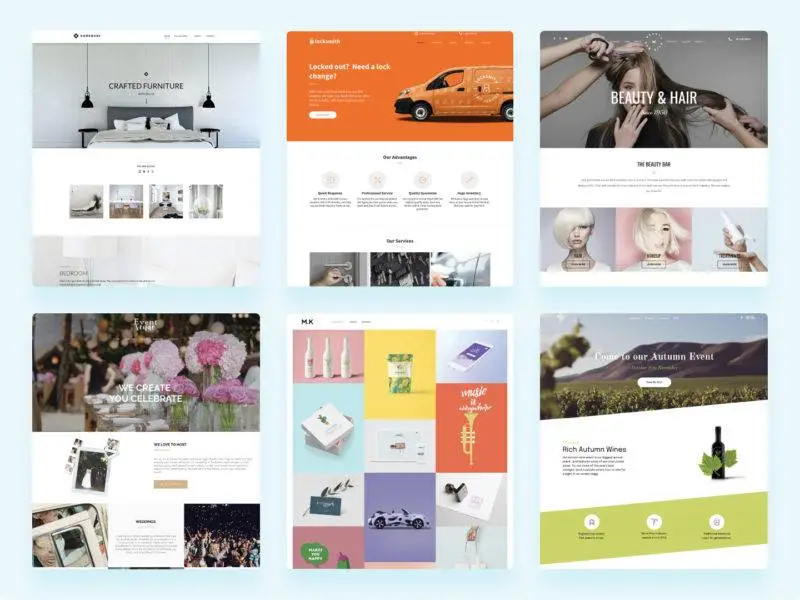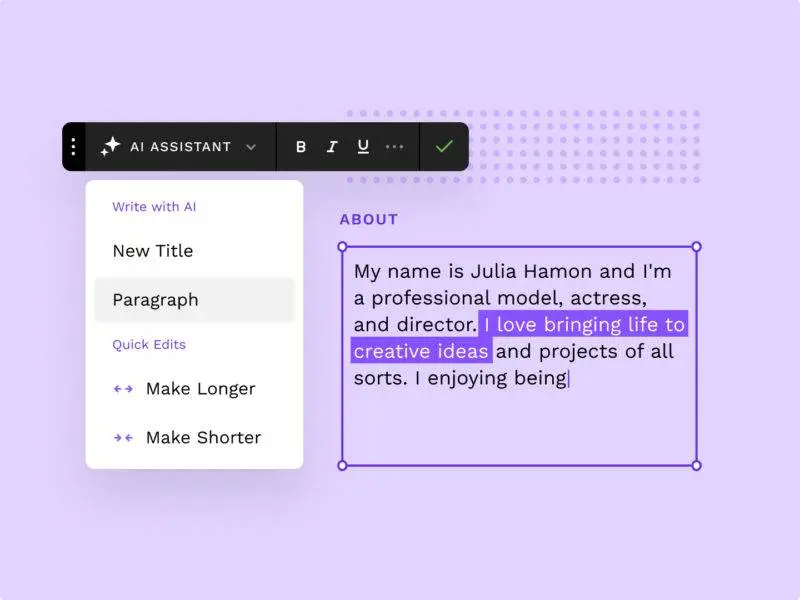For any freelance photographer looking to build their career, an online photography portfolio is a non-negotiable foundation. Why?
Because, as of 2023, there are nearly 300,000 people employed in the Photography industry in the US – the most there have ever been. That means that while demand is at its highest for freelance photographers, so is the competition.
One of the best ways for a freelance photographer to stand out from the crowd is with an exceptional online photography portfolio, one that displays your unique view of the world while also showing potential clients you’re a versatile, reliable worker.
This is exactly what we discuss in this article – what a good online photography portfolio looks like and how you can use a website builder to build the best one possible.
Who Should Consider an Online Photography Portfolio?
If you’re asking this question, chances are, you need one.

An online photography portfolio serves a broad range of people in the photography profession – from newbies to veterans, to hobbyists.
If you’re new to the industry, with aspirations of making a career as a photographer, a well-curated portfolio serves as your visual resume. It helps put your skills on display, making it easier for potential clients or employers to see how you work.
For established professionals, an updated digital portfolio shows your ability to evolve and keep pace with the ever-changing developments in technology and trends in the photography industry. This is essential, as adaptability and relevance are traits that potential clients and employers value highly.
Even if photography is your hobby or a part-time endeavor, an online portfolio provides a platform to share your work, attract a following, and perhaps transition your passion into a more lucrative opportunity.
Advantages of an Online Photography Portfolio
Firstly, accessibility is a significant asset. With your portfolio online, potential clients can view your work at any time, from anywhere in the world. This 24/7 visibility enhances your reach and opens doors to opportunities you might not have considered.
Secondly, a well-designed online portfolio serves as a compelling brand statement. It not only showcases your skills but also your unique style and approach to photography, which helps attract your brand of clients who align with your creative vision.
Yet another benefit is how easy it is to update an online portfolio (one that is hosted on a good platform, anyway). As you complete new projects and develop your skillset, ongoing curation of your portfolio demonstrates commitment to your craft, and having an easily-updated online portfolio makes that easy to achieve.
Finally, your online portfolio is one of your most powerful networking tools. Features like social sharing buttons, blog posts, and contact forms make it easier for others in the industry to connect with you and for clients to reach out directly – which helps you achieve the ultimate goal of expanding your client base and securing more work.
Elements of a Successful Online Photography Portfolio
Now that we’ve established the necessity of an online photography portfolio and its manifold benefits, let’s shift our focus to the crucial components that can make your portfolio truly stand out.
A Seamless User Experience
The ease with which visitors can navigate your portfolio directly impacts their overall impression of you.
So, you should opt for a design that is straightforward, quick to load, and compatible across devices to maximize visitor engagement. These small but crucial elements minimize friction, allowing potential clients to observe your work without any interference.

Displays Your Best Work
Your portfolio is a curated gallery designed to show off your highest-quality work, showing prospective clients a snapshot of what you’re capable of. Choose pieces that exemplify your artistic style and technical prowess, providing viewers with a window into your creative world.
Showcases Your Versatility
Include a diverse array of subjects, styles, and techniques in your portfolio. This versatility not only enriches the content but also demonstrates to potential clients your ability to handle various photography assignments.
Remains Up-to-Date with Your Recent Work
An up-to-date portfolio is a living document of your career. Consistent updates show you’re active, engaged, and evolving in your field. It also provides a platform for you to showcase how you adapt to new trends or technologies, making you an attractive choice for clients looking for a photographer who stays current.
7 Steps to Crafting The Perfect Online Photography Portfolio
Structuring Your Portfolio Sections
A well-structured portfolio mirrors a well-organized mind. It’s your first chance to show potential clients that you’re not only talented but also organized and efficient—traits that are highly sought after in any professional setting.
Start by categorizing your work. Consider creating sections based on different genres of photography you’ve worked in (e.g., portraits, landscapes, event photography). Use clear, descriptive labels for each section. Remember, the goal is to make navigating and engaging with your portfolio as easy as possible.
Creating an Engaging Intro
Along with your portfolio structure, your introduction is your first impression – and they last. Your introduction sets the tone for your entire portfolio. Thus, it should encapsulate your brand, concisely tell viewers who you are, and explain your professional abilities.

With this in mind, write a brief but compelling intro that speaks to your experience, style, and unique selling propositions. Use language that’s in line with how you wish to be perceived, be it professional, quirky, or artistic. Consider adding a high-quality portrait or action shot of you engaged in photography to make it more personal.
Showcasing Your Best Projects and Designs
This section is your portfolio’s backbone. It shows off the quality and scope of your work, convincing potential clients that you’re the right choice for their project.
Select projects that best represent your skills and versatility. Write a brief description for each project, explaining the brief, the approach you took, and why it was successful. High-resolution images are a must.
Defining Your Portfolio Goals
Having clear objectives for your portfolio helps you tailor its content and structure to meet specific career or business goals. These could range from gaining new clients, showcasing a particular skill set, or breaking into a new genre of photography.
Clearly state your goals at the beginning or end of your portfolio, or weave them subtly into your introduction and project descriptions. Make sure the content aligns with these objectives, guiding the viewer to the action you want them to take.

Compiling Authentic Client Feedback
Testimonials provide social proof, increasing your credibility and helping to alleviate any reservations a potential client might have.
Ask satisfied clients for feedback. Use quotes that are specific about what you did well and how you contributed to the project’s success. Place these testimonials in a dedicated section or intersperse them throughout your portfolio to reinforce the quality of your work.
Ensuring Accessible Contact Information
What’s the point of an impressive portfolio if clients can’t easily contact you? Your contact details should be readily accessible, encouraging potential clients to reach out.
Create a dedicated ‘Contact Me’ section. Provide multiple ways for clients to reach you—phone, email, and perhaps even a contact form. Make this section easy to find, either by placing it in the navigation or linking to it from other sections.
Adding Storytelling Flair to Your Portfolio
Storytelling adds an emotional layer to your portfolio. It makes your work relatable and memorable, distinguishing you from competitors.
Incorporate a narrative element into your project descriptions or through a blog section. Share behind-the-scenes stories, challenges you overcame, or what inspired a particular photo. This gives viewers insight into your creative process and makes your portfolio more engaging.
Stand Out with Video Hosting
Studies show that video can boost your conversion rates by up to 80%, which means you should look for a photography portfolio builder that has video hosting capacity.
Conclusion: Creating an Online Photography Portfolio That Stands Out
An outstanding online photography portfolio is your most powerful asset in capturing the attention of potential clients. It’s far more than a digital resume; it’s a dynamic showcase of your skill, versatility, and unique perspective.
When designed with care and strategic intent, it serves as a compelling narrative that not only displays your technical capabilities but also your emotional depth and understanding of your craft. So, take the time to craft a portfolio that truly reflects your expertise and makes you irresistible to clients.
It’s important, then, that anyone looking to create their online photography portfolio, selects a website builder that makes it easy for them to achieve that. Take a look at our step-by-step guide to choosing the right website builder for your needs, or take a look at our website builder feature, designed specifically for photographers to craft high-converting online portfolios.